正文
两天前在从三藩市飞回LA的飞机上刚好看到以下这篇登在LA Times上的用24小时和65美元(包括所有开销)从LA到三藩的游记,觉得非常有趣。正好从自己三藩背包行拍的照片中挑几张来配配它,也顺便做个预告。
(注:从现在开始,我贴的所有原创大图将会有双标记。)
1.我也来做个航拍(加州的中部山区)

L.A.-San Francisco Megabus tour worth pinched pennies
Leave your heart -- not your wallet -- in the Bay Area on a whirlwind 24-hour tour of the city. It's Alcatraz, cable cars and chowder, then back to L.A. Megabus' $1 fares make it happen.
By Rosemary McClure, Los Angeles Times Staff Writer
September 20, 2007
Megabus, a new travel company in California has my number -- $1.
That's how much I paid to go from Los Angeles to San Francisco last month on a bus service that whisks travelers from the Southland to the Bay Area for as little as a buck. I spent $10 to get home, but I could have scored a two-buck round trip if I had been less choosy about when I wanted to return.
The cheap transportation made possible a cut-rate mini-vacation by the bay. I hopped a cable car, wolfed down clam chowder at Fisherman's Wharf and rambled around Alcatraz, peering into cells that once housed infamous criminals. My 24-hour visit -- designed to be copied by readers -- cost $65. I may have left my heart in San Francisco, but I didn't leave my wallet.
The linchpin of this penny-pinching tour was Megabus.com, which launched its California operation in early August 2007. The big blue and gold buses connect Los Angeles with San Diego, Las Vegas, San Jose, Oakland and San Francisco. Fares run from $1 to about $35, with those who book early online at www.megabus.com receiving the lowest prices. The company already operates similar bus lines in Britain and the Midwest.
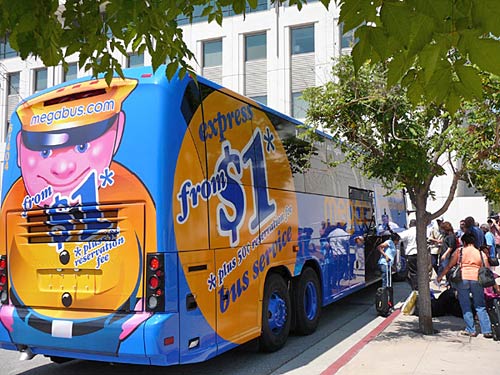
(以上图片来自原文)
One of my fellow passengers, Arthur MacBeth, a retired Los Angeles attorney, said he managed to get $1 reservations for five visiting friends to go to Las Vegas. "Five people for $5," he said, chuckling. "It's tremendous. Hard to believe, but tremendous."
MacBeth was one of the lucky ones. As I polled other passengers on my bus, I discovered that everyone had paid different fares.
Stephen Mahon, an Irish student visiting the U.S. for the summer, paid $35 each way. "It's OK," he said, "I just booked today. It's still the cheapest way I can go north."
South Gate resident Isabel Chavez, along with her mom and a friend, paid $51 total for their three round-trip tickets. Stuart Patterson, another Irish student, paid $1 for his fare from San Diego to Los Angeles and $15 for the leg to San Francisco.
Is it random luck? No, said Megabus.com President Dale Moser. "One-dollar fares are always available for a limited number of seats on every route. After the $1 tickets have sold, prices increase incrementally."
Here's a tip: The company books about 45 days in advance, he said. "So if you plan ahead and go out 45 days, you increase your probability of getting a $1 seat. As you get closer to the date you want to travel, prices increase. There are various seats at various prices. But even our top price is competitive."
To score my $11 fare, I booked three weeks in advance; Times staffers Richard Hartog and Mary Forgione, who accompanied me, booked 10 days in advance and paid $25 round-trip, plus a 50-cent booking fee. That was still a good deal when compared to Greyhound, with $75 round-trips; Amtrak, $100; and the airlines, $133.
ALL ABOARD
Our adventure began late on a Tuesday night at Los Angeles' Union Station. The overnight bus, which left at 11:30 p.m., was first-come, first-serve. In other words, no assigned seats. There were 12 of us, some carrying pillows and blankets and sacking out as soon as they boarded. The bus was new, a 56-passenger MCI J class. "This baby is one of the best buses on the interstate," driver Chada Adeyama said with a touch of pride. "It makes driving a pleasure."
As he wheeled the vehicle out onto Alameda Street, he made one announcement: "We're outta here. There's a restroom in the back and a trash bag in the front. Our next stop is Oakland."
We drove into the night and I settled into my seat, relishing the opportunity to gaze out the window instead of watching the road from behind a steering wheel. The bus seat was markedly more comfortable than any coach aircraft seat I've ever occupied. The reclining seat had plush upholstery and foot rests, and I fell asleep before we reached the Grapevine -- the busy section of Interstate 5 that winds through the Tehachapi and San Gabriel mountains and descends to the floor of the San Joaquin Valley.
I didn't awaken until we came to a stop at 3 a.m. Adeyama had exaggerated: There was a rest stop. We were at a combination gas station-market in Firebaugh, Calif., a small community in Fresno County.
"Thirty-minute stop," Adeyama announced. The bus emptied out as its 12 tousled-haired passengers sleepily filled the store, seeking a restroom and a snack. Then we milled around in the glaring light of the gas station, stretching our legs before reboarding.
Back on the highway, I glanced at the traffic; there wasn't much. Just big rigs and an occasional California Highway Patrol cruiser. Soon, I drifted off again.
"The time is now 5:37 a.m., and we are early," announced Adeyama in a voice loud enough to awaken sleeping passengers. "That beats being late."
We were at the West Oakland BART Station. Seven people got off.
The next stop was the end of the line, the Caltrain 4th Street Station in downtown San Francisco. Despite heavy traffic on the Bay Bridge, we arrived on time: 6:30 a.m. We said goodbye to Adeyama and started walking.
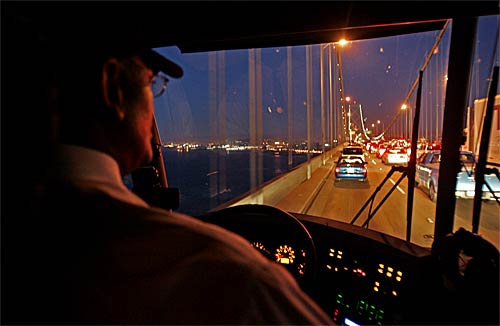
(以上图片来自原文)
With the help of the San Francisco Convention & Visitors Bureau, I had plotted an 8 1/2-hour tour that would take us to some of the city's best-known sights. The plan was to catch a Megabus back to L.A. at 3 p.m.
Our adventure would last just 24 hours, but it would give us a taste of San Francisco. And it would be a budget tour that anyone could copy -- to refresh fading memories, to entertain visiting relatives or friends, or to give students a look at the city. If the pace is too daunting, travelers can add a night or two in a hotel (but remember what that will do to the budget).
A SWEET WAKE-UP
The first stop was breakfast. We walked about a mile to Union Square, centerpiece of the city's hustling, bustling shopping district, and entered Sears Fine Food on Powell Street. The restaurant, founded in 1938, is a city institution. Its claim to fame: small Swedish pancakes that are served 18 to an order with warm maple syrup, whipped butter, bacon or link sausage. Another favorite: French toast made of sourdough French bread served with strawberry preserves (both are $7.95).
2.联合广场Union Square

We dawdled for nearly an hour over coffee and tea, then at 7:45 a.m. headed back out onto Powell, where one of the city's most colorful landmarks was rumbling by: the Powell-Mason cable car line. Richard and I ran to the stop and jumped on ($5); Mary, who planned to do the tour by foot, headed straight up -- and I do mean up -- Powell. The street seemed to be at a 45-degree angle, but Mary powered forward.
We clanged up the hill, holding on tight. Stunning views of bridges and bay, Victorian houses and stairway gardens appeared and disappeared rapidly. San Francisco's 43 hills and quirky 19th century architecture are captivating, and there's no better way to see them than from a clamoring cable car. All too soon, we had reached the end of the line at Taylor and Bay streets, and we exited, sorry to have the ride end.
We were near Fisherman's Wharf and headed for Pier 33 -- a six-block walk -- where the Alcatraz Island ferry is. We had purchased tickets in advance for the 9:30 a.m. tour ($24.50) and met Mary at the pier. None of us had visited the historic site before, and we were looking forward to exploring the onetime federal penitentiary. The prison, which operated here from 1934 to 1963, housed such inmates as Al "Scarface" Capone and Robert Stroud, better known as the "Birdman of Alcatraz."
The boat ride was a disappointing 12 minutes -- the view of the San Francisco skyline is so spectacular that I would have liked to have spent more time on the water to fully enjoy it -- but once we arrived, we found new distractions. Former prisoner Darwin Coon, a bank robber, was holding court outside the entrance.
3.大家都来闯THE ROCK
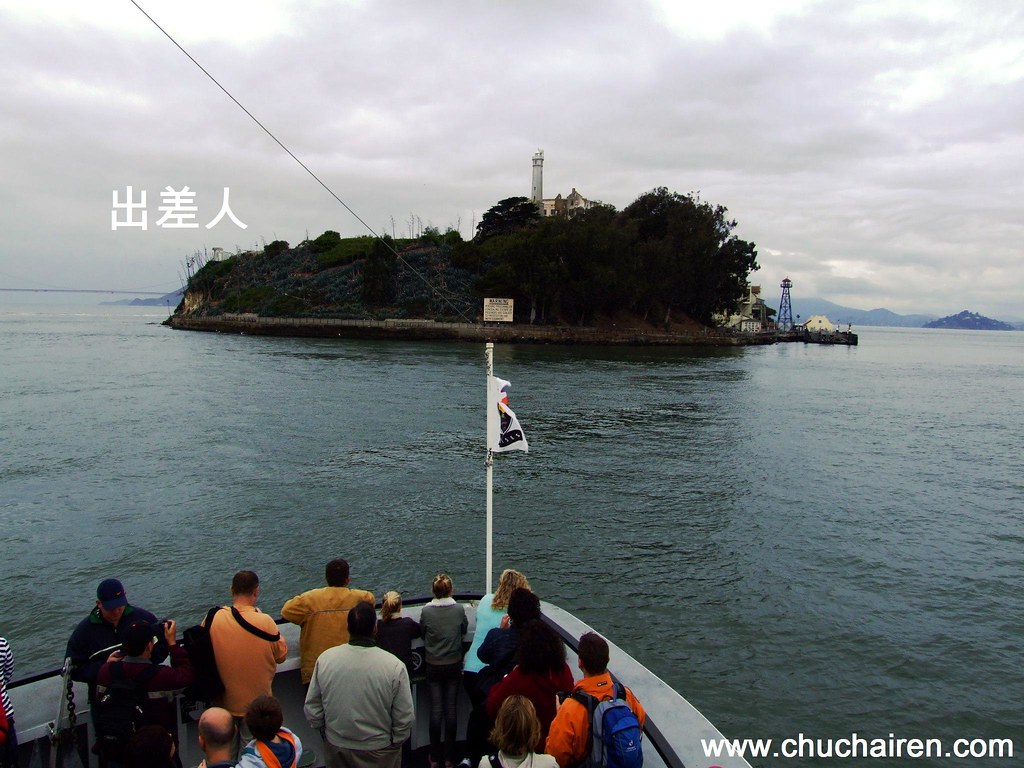
"It was a living hell," said Coon, who now signs copies of his book, "Alcatraz: The True End of the Line," for tourists. "The only way I made it was to live one day at a time."
We climbed the hill to the prison and poked around inside its grim walls, trying out cells and isolation rooms, visiting the cafeteria, listening to taped comments by inmates. Then we emerged on the outside of the prison, where a dramatic view of the city awaited.
The rough, chilly waters surrounding "The Rock" made it easy to see why Alcatraz was considered relatively escape-proof. In the 29 years that the island served as a federal prison, 36 inmates tried to flee. Three who may have made it dug through concrete and left dummy heads in their cells during a 1962 breakout; their plot was the focus of the 1979 Clint Eastwood film "Escape From Alcatraz."
4.Alcatraz监狱里的三层牢房
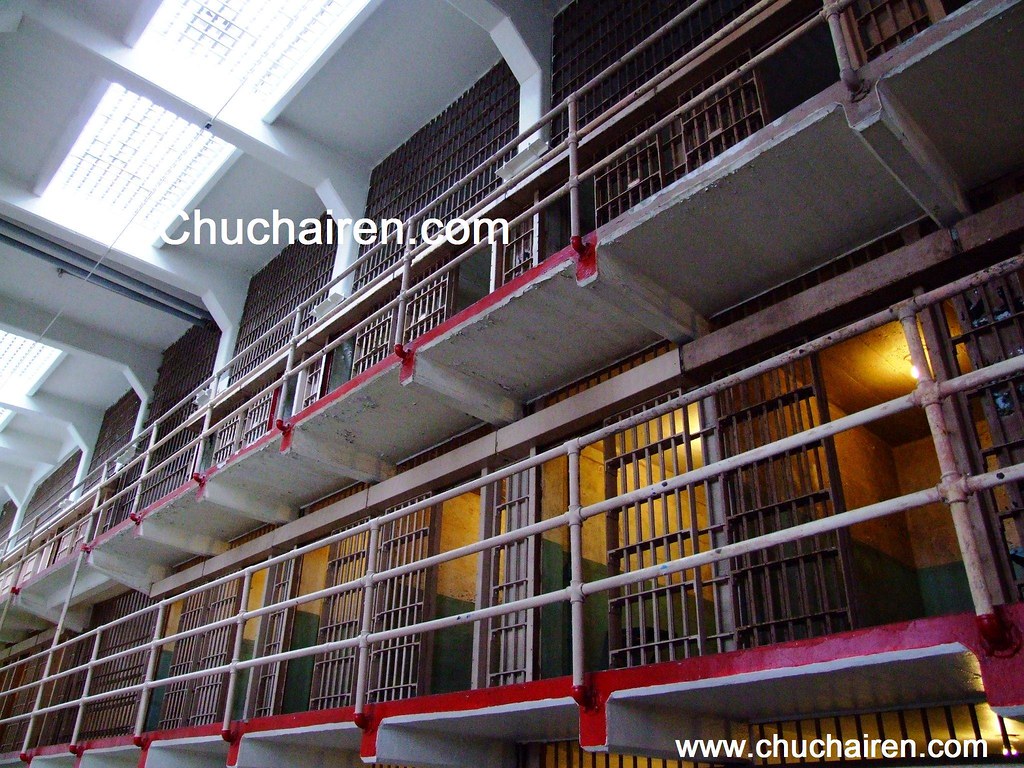
5.美国历史上一些最臭名昭著的犯人
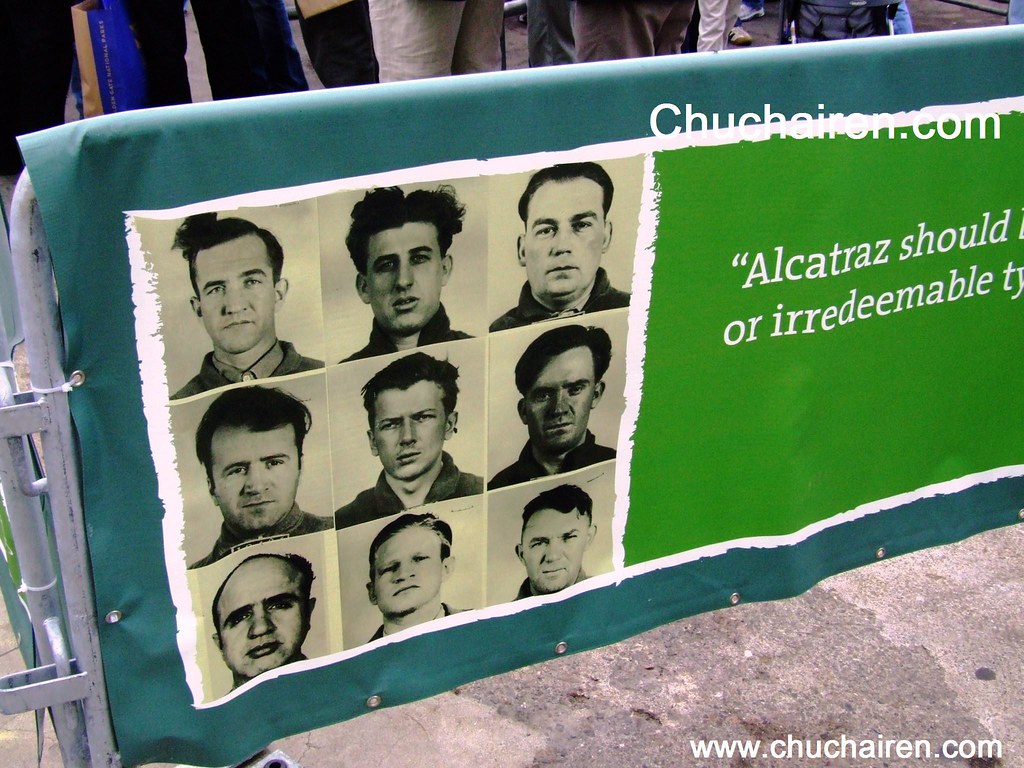
The former prison, part of the Golden Gate National Recreation Area, has self-guided tours, and visitors can stay as long as they want. But we had a schedule to keep, so we took the ferry back to the mainland at 11:30 a.m., bound for lunch at Fisherman's Wharf. This area, once home to a large fishing fleet, is now more of a tourist trap than a working wharf. Ripley's Believe It or Not! is among the many museums there. But no visit to San Francisco is complete without a walk around Fish Alley.
FISH ALLEY FARE
The center of this universe is the intersection of Jefferson and Taylor streets, where we saw a few of the local fishing boats that remain active. Then we strolled down a passageway packed with stalls where Dungeness crab simmered in steaming pots and vendors hawked crab and shrimp cocktails and clam chowder. The food looked inviting (and was inexpensive), but more than anything else, we needed some time to sit down, so we walked upstairs to Alioto's No. 8 for lunch.
The restaurant, similar to Sears, is a local institution. Founded in 1925, it has been run by three generations of the Alioto family. We had chowder ($10) and watched sea gulls soaring over fishing boats with names such as Johnny L, High Hope and the Sandra Dee.
Our itinerary was calling, so we walked a few blocks south and, at the corner of Beach and Mason streets, caught a Muni F-line streetcar ($1.50), which deposited us in front of the Ferry Building. It was our last stop. This venerable city landmark, built in 1898 and renovated in 2003, is a picturesque public market with food shops, cafes and outdoor markets. I picked up a chicken sandwich ($5) at Mistral Rotisserie Provencale for the trip home.
6.时间仿佛停止在唐人街

7.三藩市现代艺术博物馆(简称:SFMOMA。看完出来后的感觉是:现代艺术就是天马行空般的随手拈来。呵呵。)
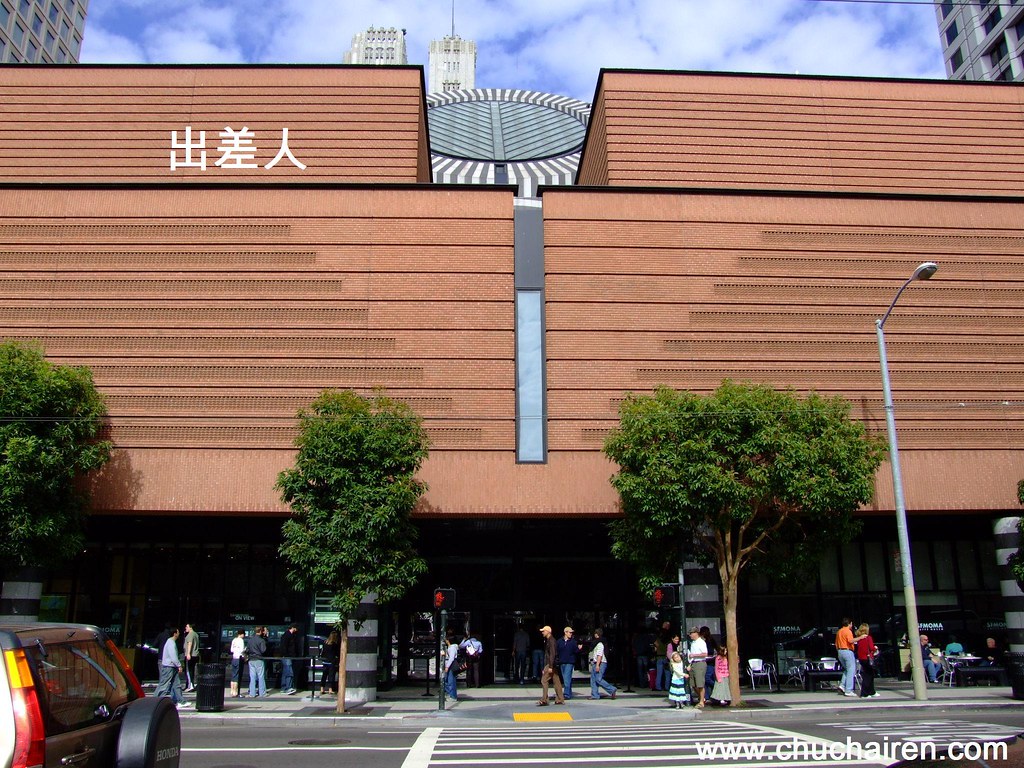
We boarded the bus at 3 p.m. at the Caltrain 4th Street Station for our return trip, and arrived in Los Angeles around 11 p.m.
If I were to make this trip again, would I do anything different? I might extend my tour another eight hours by taking the 11:30 p.m. Megabus south; it's one of three scheduled trips a day.
Then I'd add a visit to Coit Tower, a walk across the Golden Gate Bridge and enjoy an inexpensive dinner in Chinatown.
All I'd need would be half-a-dozen cans of Red Bull to do it all.
(注:从现在开始,我贴的所有原创大图将会有双标记。)
1.我也来做个航拍(加州的中部山区)

L.A.-San Francisco Megabus tour worth pinched pennies
Leave your heart -- not your wallet -- in the Bay Area on a whirlwind 24-hour tour of the city. It's Alcatraz, cable cars and chowder, then back to L.A. Megabus' $1 fares make it happen.
By Rosemary McClure, Los Angeles Times Staff Writer
September 20, 2007
Megabus, a new travel company in California has my number -- $1.
That's how much I paid to go from Los Angeles to San Francisco last month on a bus service that whisks travelers from the Southland to the Bay Area for as little as a buck. I spent $10 to get home, but I could have scored a two-buck round trip if I had been less choosy about when I wanted to return.
The cheap transportation made possible a cut-rate mini-vacation by the bay. I hopped a cable car, wolfed down clam chowder at Fisherman's Wharf and rambled around Alcatraz, peering into cells that once housed infamous criminals. My 24-hour visit -- designed to be copied by readers -- cost $65. I may have left my heart in San Francisco, but I didn't leave my wallet.
The linchpin of this penny-pinching tour was Megabus.com, which launched its California operation in early August 2007. The big blue and gold buses connect Los Angeles with San Diego, Las Vegas, San Jose, Oakland and San Francisco. Fares run from $1 to about $35, with those who book early online at www.megabus.com receiving the lowest prices. The company already operates similar bus lines in Britain and the Midwest.

(以上图片来自原文)
One of my fellow passengers, Arthur MacBeth, a retired Los Angeles attorney, said he managed to get $1 reservations for five visiting friends to go to Las Vegas. "Five people for $5," he said, chuckling. "It's tremendous. Hard to believe, but tremendous."
MacBeth was one of the lucky ones. As I polled other passengers on my bus, I discovered that everyone had paid different fares.
Stephen Mahon, an Irish student visiting the U.S. for the summer, paid $35 each way. "It's OK," he said, "I just booked today. It's still the cheapest way I can go north."
South Gate resident Isabel Chavez, along with her mom and a friend, paid $51 total for their three round-trip tickets. Stuart Patterson, another Irish student, paid $1 for his fare from San Diego to Los Angeles and $15 for the leg to San Francisco.
Is it random luck? No, said Megabus.com President Dale Moser. "One-dollar fares are always available for a limited number of seats on every route. After the $1 tickets have sold, prices increase incrementally."
Here's a tip: The company books about 45 days in advance, he said. "So if you plan ahead and go out 45 days, you increase your probability of getting a $1 seat. As you get closer to the date you want to travel, prices increase. There are various seats at various prices. But even our top price is competitive."
To score my $11 fare, I booked three weeks in advance; Times staffers Richard Hartog and Mary Forgione, who accompanied me, booked 10 days in advance and paid $25 round-trip, plus a 50-cent booking fee. That was still a good deal when compared to Greyhound, with $75 round-trips; Amtrak, $100; and the airlines, $133.
ALL ABOARD
Our adventure began late on a Tuesday night at Los Angeles' Union Station. The overnight bus, which left at 11:30 p.m., was first-come, first-serve. In other words, no assigned seats. There were 12 of us, some carrying pillows and blankets and sacking out as soon as they boarded. The bus was new, a 56-passenger MCI J class. "This baby is one of the best buses on the interstate," driver Chada Adeyama said with a touch of pride. "It makes driving a pleasure."
As he wheeled the vehicle out onto Alameda Street, he made one announcement: "We're outta here. There's a restroom in the back and a trash bag in the front. Our next stop is Oakland."
We drove into the night and I settled into my seat, relishing the opportunity to gaze out the window instead of watching the road from behind a steering wheel. The bus seat was markedly more comfortable than any coach aircraft seat I've ever occupied. The reclining seat had plush upholstery and foot rests, and I fell asleep before we reached the Grapevine -- the busy section of Interstate 5 that winds through the Tehachapi and San Gabriel mountains and descends to the floor of the San Joaquin Valley.
I didn't awaken until we came to a stop at 3 a.m. Adeyama had exaggerated: There was a rest stop. We were at a combination gas station-market in Firebaugh, Calif., a small community in Fresno County.
"Thirty-minute stop," Adeyama announced. The bus emptied out as its 12 tousled-haired passengers sleepily filled the store, seeking a restroom and a snack. Then we milled around in the glaring light of the gas station, stretching our legs before reboarding.
Back on the highway, I glanced at the traffic; there wasn't much. Just big rigs and an occasional California Highway Patrol cruiser. Soon, I drifted off again.
"The time is now 5:37 a.m., and we are early," announced Adeyama in a voice loud enough to awaken sleeping passengers. "That beats being late."
We were at the West Oakland BART Station. Seven people got off.
The next stop was the end of the line, the Caltrain 4th Street Station in downtown San Francisco. Despite heavy traffic on the Bay Bridge, we arrived on time: 6:30 a.m. We said goodbye to Adeyama and started walking.

(以上图片来自原文)
With the help of the San Francisco Convention & Visitors Bureau, I had plotted an 8 1/2-hour tour that would take us to some of the city's best-known sights. The plan was to catch a Megabus back to L.A. at 3 p.m.
Our adventure would last just 24 hours, but it would give us a taste of San Francisco. And it would be a budget tour that anyone could copy -- to refresh fading memories, to entertain visiting relatives or friends, or to give students a look at the city. If the pace is too daunting, travelers can add a night or two in a hotel (but remember what that will do to the budget).
A SWEET WAKE-UP
The first stop was breakfast. We walked about a mile to Union Square, centerpiece of the city's hustling, bustling shopping district, and entered Sears Fine Food on Powell Street. The restaurant, founded in 1938, is a city institution. Its claim to fame: small Swedish pancakes that are served 18 to an order with warm maple syrup, whipped butter, bacon or link sausage. Another favorite: French toast made of sourdough French bread served with strawberry preserves (both are $7.95).
2.联合广场Union Square

We dawdled for nearly an hour over coffee and tea, then at 7:45 a.m. headed back out onto Powell, where one of the city's most colorful landmarks was rumbling by: the Powell-Mason cable car line. Richard and I ran to the stop and jumped on ($5); Mary, who planned to do the tour by foot, headed straight up -- and I do mean up -- Powell. The street seemed to be at a 45-degree angle, but Mary powered forward.
We clanged up the hill, holding on tight. Stunning views of bridges and bay, Victorian houses and stairway gardens appeared and disappeared rapidly. San Francisco's 43 hills and quirky 19th century architecture are captivating, and there's no better way to see them than from a clamoring cable car. All too soon, we had reached the end of the line at Taylor and Bay streets, and we exited, sorry to have the ride end.
We were near Fisherman's Wharf and headed for Pier 33 -- a six-block walk -- where the Alcatraz Island ferry is. We had purchased tickets in advance for the 9:30 a.m. tour ($24.50) and met Mary at the pier. None of us had visited the historic site before, and we were looking forward to exploring the onetime federal penitentiary. The prison, which operated here from 1934 to 1963, housed such inmates as Al "Scarface" Capone and Robert Stroud, better known as the "Birdman of Alcatraz."
The boat ride was a disappointing 12 minutes -- the view of the San Francisco skyline is so spectacular that I would have liked to have spent more time on the water to fully enjoy it -- but once we arrived, we found new distractions. Former prisoner Darwin Coon, a bank robber, was holding court outside the entrance.
3.大家都来闯THE ROCK

"It was a living hell," said Coon, who now signs copies of his book, "Alcatraz: The True End of the Line," for tourists. "The only way I made it was to live one day at a time."
We climbed the hill to the prison and poked around inside its grim walls, trying out cells and isolation rooms, visiting the cafeteria, listening to taped comments by inmates. Then we emerged on the outside of the prison, where a dramatic view of the city awaited.
The rough, chilly waters surrounding "The Rock" made it easy to see why Alcatraz was considered relatively escape-proof. In the 29 years that the island served as a federal prison, 36 inmates tried to flee. Three who may have made it dug through concrete and left dummy heads in their cells during a 1962 breakout; their plot was the focus of the 1979 Clint Eastwood film "Escape From Alcatraz."
4.Alcatraz监狱里的三层牢房

5.美国历史上一些最臭名昭著的犯人

The former prison, part of the Golden Gate National Recreation Area, has self-guided tours, and visitors can stay as long as they want. But we had a schedule to keep, so we took the ferry back to the mainland at 11:30 a.m., bound for lunch at Fisherman's Wharf. This area, once home to a large fishing fleet, is now more of a tourist trap than a working wharf. Ripley's Believe It or Not! is among the many museums there. But no visit to San Francisco is complete without a walk around Fish Alley.
FISH ALLEY FARE
The center of this universe is the intersection of Jefferson and Taylor streets, where we saw a few of the local fishing boats that remain active. Then we strolled down a passageway packed with stalls where Dungeness crab simmered in steaming pots and vendors hawked crab and shrimp cocktails and clam chowder. The food looked inviting (and was inexpensive), but more than anything else, we needed some time to sit down, so we walked upstairs to Alioto's No. 8 for lunch.
The restaurant, similar to Sears, is a local institution. Founded in 1925, it has been run by three generations of the Alioto family. We had chowder ($10) and watched sea gulls soaring over fishing boats with names such as Johnny L, High Hope and the Sandra Dee.
Our itinerary was calling, so we walked a few blocks south and, at the corner of Beach and Mason streets, caught a Muni F-line streetcar ($1.50), which deposited us in front of the Ferry Building. It was our last stop. This venerable city landmark, built in 1898 and renovated in 2003, is a picturesque public market with food shops, cafes and outdoor markets. I picked up a chicken sandwich ($5) at Mistral Rotisserie Provencale for the trip home.
6.时间仿佛停止在唐人街

7.三藩市现代艺术博物馆(简称:SFMOMA。看完出来后的感觉是:现代艺术就是天马行空般的随手拈来。呵呵。)

We boarded the bus at 3 p.m. at the Caltrain 4th Street Station for our return trip, and arrived in Los Angeles around 11 p.m.
If I were to make this trip again, would I do anything different? I might extend my tour another eight hours by taking the 11:30 p.m. Megabus south; it's one of three scheduled trips a day.
Then I'd add a visit to Coit Tower, a walk across the Golden Gate Bridge and enjoy an inexpensive dinner in Chinatown.
All I'd need would be half-a-dozen cans of Red Bull to do it all.
评论
目前还没有任何评论
登录后才可评论.




